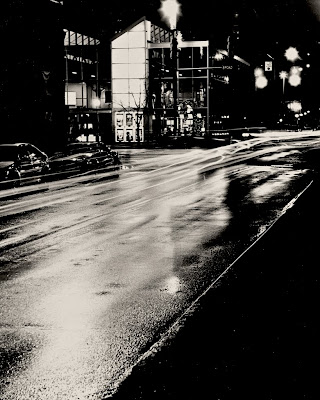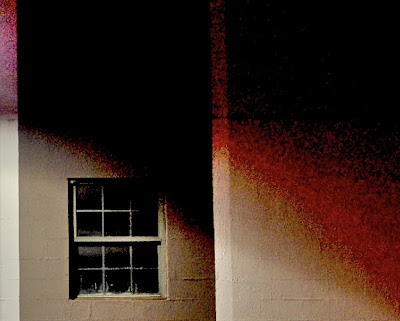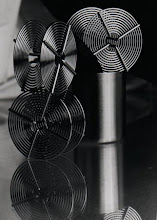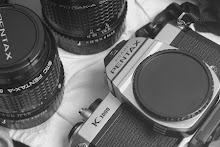
Movie Theater, Chattanooga.
Pentax K1000, 645 55mm; Pan F+ 32 ASA, D76 1+1; VCII printing on Ilford MG IV RC.
The street was dry as this photo was made; the bulb exposure of a high contrast area helps the street appear wet and slick, but it was actually dry and cold that night. The variance in brightness of the asphalt is actually the result of the angles of reflection; the family of angles between the camera, the lamp, and the surface of the street.
Autoviewer Slideshow. Click on the pictures to play the slideshow.
by John O'Keefe-Odom
AgXphoto.info
If we asked someone to spend untold millions to string up thousands of lights in a sprawling pattern so that we could illuminate a two mile radius every night, they'd think we're a bunch of crackpots.
We do it every night with street lamps.
Streetlights are one of our most common and overlooked sources of continuous lighting. Individually, we probably couldn't tote or afford to operate a single one of them by ourselves.
If you carried one of those lamps out there, maybe with a generator or a bunch of batteries; even if you had the electrical know-how to get the thing going, we wouldn't expect you to last long.
Street lamps operate almost all night long; sometimes with subtle differences based on day of the week, or time of night; but we use and ignore them all the time.
Every small town in America has unrolled the red carpet for you and your tripod. They installed street lights.
Some tips:
- Get past the headlight thing. We all know those make trails. What other lights do you see?
- Look for shadow patterns. Those lamps cast direct light, but that means they are also casting shadows. Use those shadows to your advantage.
- Is it damp, drizzling rain, cold and miserable? Good! Wet concrete is more reflective; poor weather conditions can enhance some of the street lamp lighting effects. As long as you can operate the camera without it fogging up or freezing, you are good to go.
- Compose the photo; exploit geometric lines and shapes. Manmade objects are one big gallery of Euclidian geometry. Approach photographing them from a slightly different angle, and those straight lines (like sidewalks and curbs) can become effective diagonals to lead the eye of the viewer.
- Check exposure. A lot of these exposures for film speeds below 1600 will work out to be 30 seconds to a minute at f/8. At 32ASA, I find many fall in around one minute at f/8.
- Digital imaging: exploit that white balance adjustment, and consider recording in daylight and processing in tungsten, or vice versa.
- Consider selective flash use; maybe snooted flash directed at an important detail.
Nighttime is a great opportunity for one of the world's largest displays of continuous lighting.

Pentax K200D, 28-80 FAJ.
# # #

.jpg)







